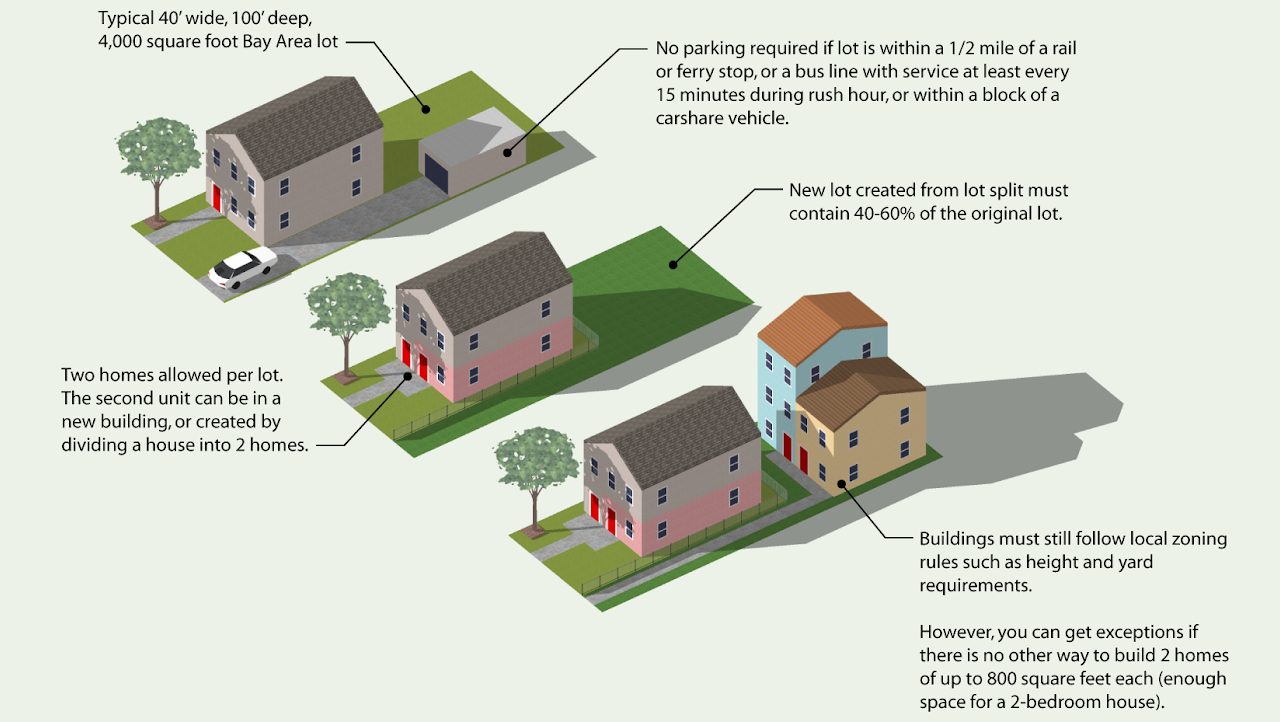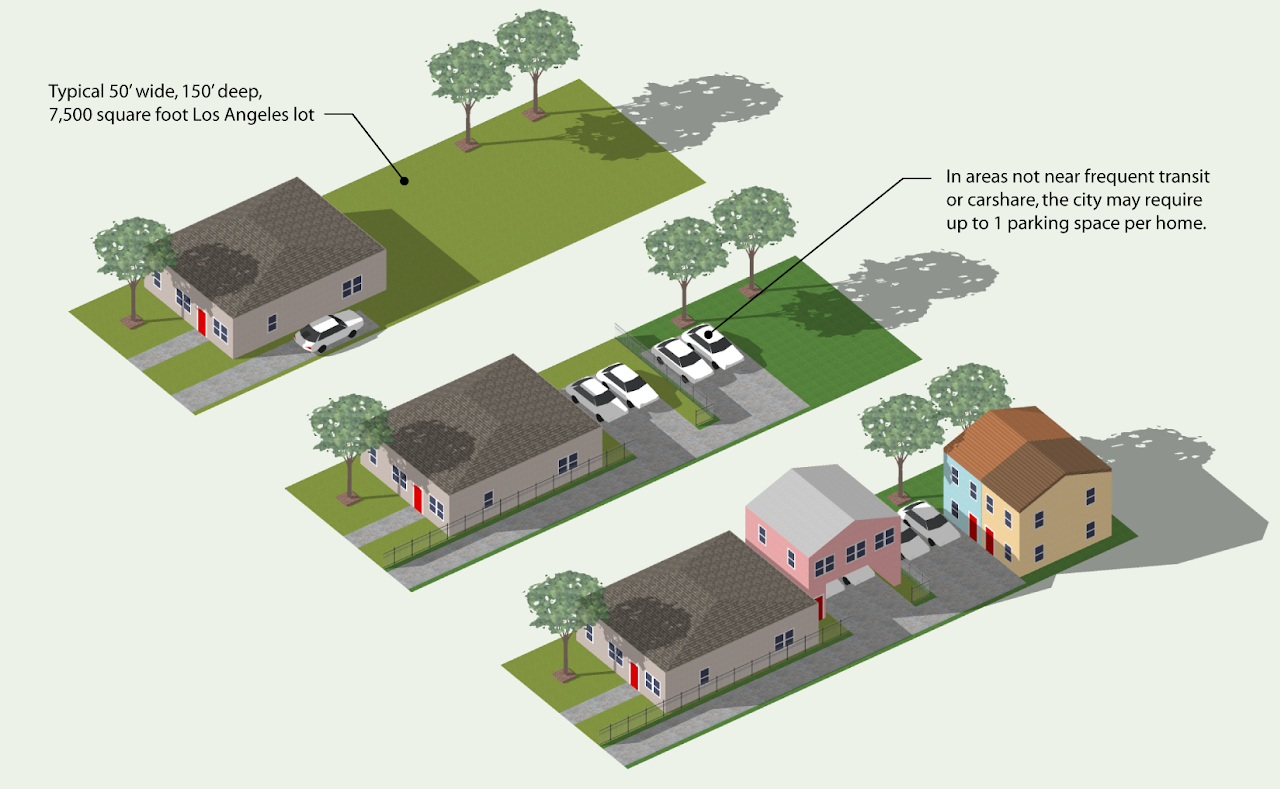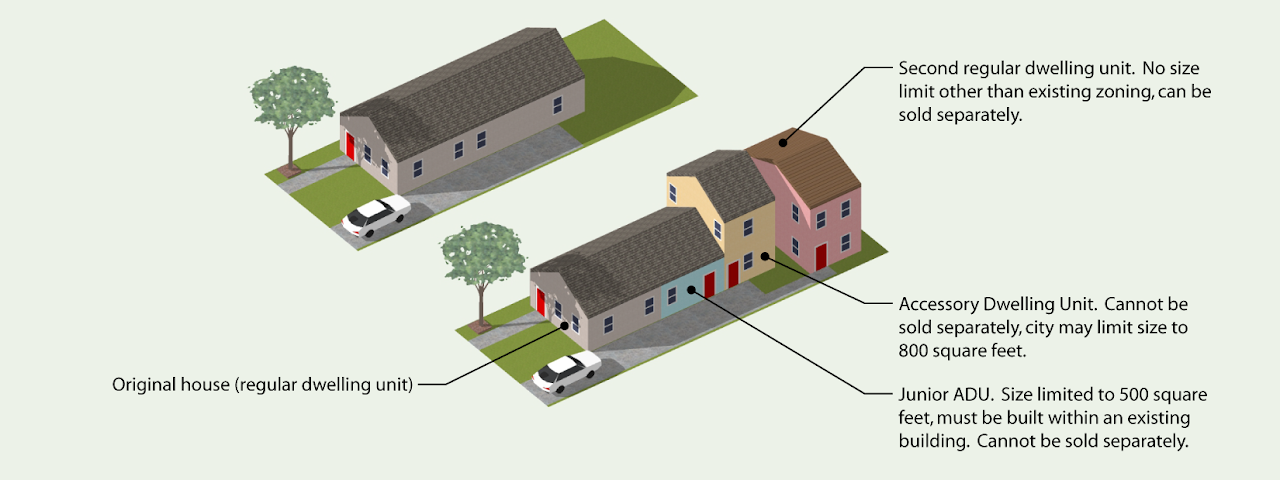SB 9
Nickname: California HOME Act
Subject: Duplexes and Lot Splits
Sponsor: Sen. Atkins
Year: 2021
What is SB 9?
SB 9 allows most California homeowners to build two units of housing on a lot that is zoned for only a single-family home. It also allows homeowners to split a lot with single-family zoning into two lots, and develop one or both of the new lots with single family homes, accessory dwelling units (also called ADUs), or a duplex. Finally, SB 9 creates new opportunities for homeowners interested in building ADUs.
Where Does SB 9 Apply?
To take advantage of SB 9 to build two units of housing on your lot, split your lot, or both, your lot must meet the following criteria:
- It must be located in a single-family residential zone.
- It must be located in an urban area. If the lot is in an incorporated city or town, it will almost always qualify for SB 9. If the lot is not in an incorporated city or town, it must be entirely within an “urbanized area or urban cluster” as defined by the U.S. Census Bureau.
If you want to use SB 9 and believe your lot meets the requirements, or if you are not sure about something, you should contact your local planning commission. They will be able to answer your questions and guide you through the application process.
If your lot does not qualify for SB 9, in most cases you will still be able to build an ADU on your property. See here for CalHDF’s guide to California’s ADU laws.
Restrictions on Where SB 9 Applies
General
There are numerous places where you cannot use SB 9. Some of these are technical designations that you should consult a local land use lawyer about. If you live in a large or medium-sized city, it is unlikely any of them will apply to you, except, possibly, the historic district designation. You cannot use SB 9 if your lot falls into the following categories:
- Prime farmland or an area designated for agricultural preservation;
- Wetlands;
- A high fire hazard zone (unless you agree to implement fire hazard mitigation measures outlined in state law);
- A hazardous waste site;
- An earthquake fault zone;
- An area prone to flooding;
- A habitat conservation area or habitat for endangered plant or wildlife species;
- Land under a conservation easement;
- A historic district or historic landmark.
Coastal Zones
If you are in the coastal zone, you will still need a coastal development permit from your local government to use SB 9. In most cases, you should be able to get the permit, and SB 9 says there cannot be a public hearing as part of the application process.
Current and Recent Rentals
SB 9 includes some protections for renters. You cannot use SB 9 to demolish or alter affordable housing, housing that falls under local rent control or price control rules, or housing that has been occupied by a tenant at any point in the last three years. In addition, if the Ellis Act has been used to evict a tenant on the property in the last fifteen years, you cannot take advantage of SB 9.
Owner-Occupancy Requirement
You must also intend to live in one of the units on the property for at least three years, whether you build a duplex, split your lot, or do both. And you cannot rent out a unit that was created using SB 9 on a short-term basis. (In other words, no renting out your new units on Airbnb.)
HOAs
Finally, if you are part of a homeowners association, you will likely need their approval to use SB 9.
Lot Splits under SB 9
The two proposed lots must meet the following requirements:
- Each lot must be at least 1,200 square feet, unless your local government explicitly allows them to be smaller.
- The two lots must be relatively equal in size. The smaller of the two must be at least 40% of the area of the full original lot. (I.e., you cannot do more than a 40/60 split of your property.)
You cannot:
- Use SB 9 to split two lots that are next to each other and owned by the same person.
- Use SB 9 to split a lot that has already been the subject of an SB 9 lot split.
- Engage in any non-residential use of a lot created through an SB 9 lot split.
If your proposed lot split meets the requirements, the local government must “ministerially approve” your application. “Ministerial approval” means that if your application meets all objective, non-discretionary standards for subdividing property, the local government must approve it. Think of this as the local government going through a checklist of clear, objective requirements: if your application ticks all the boxes, it gets approved. Furthermore, the local government cannot hold a hearing on your application, and if any part of your existing property violates the zoning code, the local government cannot require you to fix it as a condition of approving the lot split.
Some examples of what your local government may require include:
- Easements to allow public services (e.g. electricity, plumbing) to be delivered to each lot.
- Both lots must have access to a public road.
After you have split your lot, you can use SB 9 to build up to two units on each of your two lots.
Building Housing under SB 9
Local governments must grant ministerial approval to your application if you want to build two units on a single-family lot, or up to two units on a lot created as the result of an SB 9 lot split. The two units per lot can be in the form of a duplex or a single-family home and an ADU or a Junior ADU.
It is also possible to use SB 9 to build a duplex on a single-family lot, and then add up to two ADUs to the same lot. Each step of this process is, again, entitled to ministerial approval.
Illustrations
Below is an illustration (credit to Alfred Twu) of how you might take advantage of SB 9 on a typical Bay Area lot.

And a typical lot in or around Los Angeles (again, credit to Alfred Twu):

Can Local Governments Add More Restrictions?
The local government’s objective standards for lot splits and housing construction still apply. Objective standards are clear, measurable requirements that do not grant any discretion to city officials. (For example, a 25-foot height limit is an objective standard, but a rule that new construction must “match the architecture of the neighborhood” is not.)
There are limits on what objective standards a local government can use to reject your application. Obviously, any objective standard that explicitly prevents you from building two units on the lot does not apply. Objective standards that would prevent either unit from being at least 800 square feet also do not apply.
Setbacks
Local governments can require that new buildings be set back from the edge of the lot, but they are limited to a four foot setback (or less) from side and rear property lines. However, if you are replacing an existing structure, the local government cannot use setback rules to stop you, so long as the new structure is built on the footprint of the old one. Also, you can use SB 9 to build adjacent or connected structures as long as they satisfy the building code and are designed in a way that allows them to be sold separately. This includes building a duplex on a single lot with two connected units as well as splitting your lot and then building two connected townhome-style duplexes – one on each lot.
Parking
Local governments can also impose parking requirements. Depending on local rules, you may be required to provide up to one off-street parking spot per unit. In the following cases, though, local governments cannot impose any parking requirements:
- Within half a mile of a bus route that comes at least every 15 minutes during rush hour.
- Within half a mile of a rail or bus rapid transit stop or a ferry terminal served by bus.
- If there is a car share vehicle within one block.
Current and Recent Rentals
In addition to the renter protections discussed above, SB 9 will not allow you to demolish more than 25% of the existing exterior walls of a structure if it has been occupied by a tenant at any point in the last three years. SB 9 does allow local governments to waive or loosen this restriction, however, so if you are thinking of doing this, check your local regulations.
Are There Tax Implications of Using SB 9?
There may be tax implications of using SB 9 to split your lot or build new housing units. In general, you should consult your local government’s tax assessor or a local tax lawyer before committing to anything. In addition to potential new tax liability, the local government can charge its standard fees related to housing construction for units built using SB 9.
How Does SB 9 Affect ADUs?
With some restrictions, you can combine state ADU laws with SB 9 in a number of different ways. The main limitation is that you cannot use the combination of SB 9 and state ADU law to develop more than four units on a lot previously zoned for a single-family home. You cannot use a lot created through an SB 9 lot split to build a duplex and then, on top of that, build an ADU on the same lot. Local governments can allow this if they want (check your local zoning code and/or consult a local land use lawyer or your planning commission if you’re interested in doing this!) but SB 9 does not force them to permit more than two units of housing on a lot created through an SB 9 lot split.
That said, you can use SB 9 to split your lot and then put a single-family home plus an ADU on each new lot (for a total of four units). You can also use SB 9 to build a duplex without doing a lot split, and then add two ADUs to the same lot, as in the illustration below (credit to Alfred Twu). You can read more about statewide laws on ADUs here.

Furthermore, SB 9’s rules for building two units on one lot apply to a single-family home/ADU pair just as much as they apply to duplexes. That means ministerial approval for your application, limits on what setback requirements can be imposed, and limited parking requirements—along with everything else discussed above. In many cases, statewide law on ADUs already provides the same protections, but it’s nice to have SB 9 confirming your rights as a homeowner.
If you are considering using SB 9 to build two units on one lot (before or after a lot split), you should evaluate whether it would be better to build a duplex or a single-family home plus an ADU. There are advantages and disadvantages to both options, and which one works best will depend on your goals and your circumstances. These resources may be helpful as you make your decision:
- A fact sheet from the state government about SB 9. This provides more detail about how SB 9 works than the explanations on this webpage.
- A blog post by a construction company going through the advantages and disadvantages of building an ADU versus using SB 9.
- A blog post by a different construction company that lays out the advantages and disadvantages of building an ADU versus using SB 9.
- A YouTube video by an ADU consultant about the situations where using SB 9 is a better option than building an ADU, and vice versa.
As you may have gathered from the list of resources above, there are plenty of companies that specialize in helping homeowners build more housing on their property, and they would be happy to talk to you about your plans. Note: CalHDF is not affiliated with any of these companies and does not officially endorse them.
